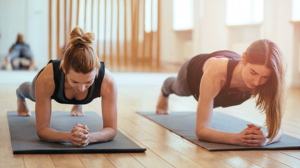Table of Contents
Many people who work out regularly are not sure about whether they should warm-up before exercising. If you are trying to build muscle or bulk up, you might wonder whether the extra calories that are burned while warming up will negatively affect muscle growth. If you are an endurance exercise enthusiast, you might wonder whether a warm-up routine might start to tire the muscles before the actual exercise.
Today I would like to tell you why warming up won’t negatively affect muscle growth or performance. In contrary, warm-up exercises will actually increase performance and growth. Before we get to that, let’s first consider two extremely important side notes:
Don’t be scared of burning extra calories when warming up
This is such a big point that I want to shout it from the rooftops. Many new exercisers work out so hard and try to give their bodies all that they can to grow and improve. Well done to you for that. You deserve a medal. But don’t become so extreme that you end up hurting your progress. Some of the ways that people take their new exercise routines to the extreme is by cutting out more of a certain food group that what they need to or by exercising more than what their bodies can handle. Both of these extremes will negatively affect your progress.
Voluntarily sedentary
Another one of these extremes is what I call becoming ‘voluntarily sedentary’. You know about the importance of rest and take it so far that you get worried every time you need to do anything that might tire your muscles. You are scared that it will either lengthen their recovery time or deplete precious nutrients.
Lack of movement hampers recovery
This can’t be further from the truth. Not moving your muscles enough is more likely to hamper recovery than moving them too much in day-to-day life. Your muscles need blood flow. Movement signals the need for blood flow. Lack of movement also slows down recovery because your body is thrown between two extremes: High-intensity movement and almost no movement at all. This decreases your muscles’ ability to adapt.
Don’t do static stretching as a warm-up exercise
This point is just as important. Warm-up exercises prime the muscles for the upcoming activity. For this reason, you want to do exercises that are energetic in nature. This will cause the body to increase its nutrient supply to your muscles.
Static stretches are very relaxing by nature. A relaxed muscle is your friend when you want it to recover. On the other hand, a relaxed muscle is not your friend when you want it to perform. Since static stretches relax the muscles, they may reduce performance and actually increase the risk of injury. A relaxed muscle might elongate longer than it should during exercise and lead to a tear or a joint injury. If you enjoy doing stretches as a warm-up exercise, try switching to dynamic stretching.
Dynamic stretching
Dynamic stretching includes movement within the stretch. This helps to prime them for movement. Static stretches are stretch-and-hold. Dynamic stretches are bouncy. An example of a static stretch will be toe touches where you hold the position for ten seconds. Swinging your arms back and forth is a great example of a chest and back dynamic stretch.Learn more about the difference between static and dynamic stretching here.
The benefits of warming up
Now that we have covered the basics, let’s get into why you should be warming up before every major exercise session.
Warming up helps to prevent injury
Warming up will help to prevent injury in a variety of ways. One of these ways is through increased blood flow. This opens up the blood vessels and gets oxygen pumping in increased quantities. It also activates the release of energetic nutrients like glycogen and fat molecules (or lipids). Amino acids, the building blocks of protein, are also released during a good warm-up. By increasing internal access to these nutrients before a major exercise, the body has more of these nutrients available to perform and recover. This increases ability and therefore reduces injury risk.
The second way that warming up reduces the risk of injury is by tensing the muscle fibers. Your muscle fibers tense when they are activated via exercise. They do this to prepare for a physical workload and negate the risk of injury.
Warming Up Improves Performance
Increased blood flow and muscles that are a little more tensed are also the reasons why warming up will improve your performance. A good warm-up session will put them in ‘go mode’. Since oxygen is already being pumped into your muscles, lactic acid will take longer to cause that burning sensation that you feel during exercise.
Warming Up Increases Recovery
Increase blood flow, increased nutrient availability and increased muscle tension will allow your body to start the recovery process during exercise. You are basically turning on the recovery tap of nutrients much sooner than if you didn’t warm up. Since warming up increases performance and decreases muscle damage, you will also be able to do more while needing less recovery.
How to Warm Up Properly
As the name suggests, warm-up exercises should increase the heat in your body to encourage blood flow. That is why steam rooms increase recovery. A warm-up exercise should start to tax the muscles so that they respond by increasing blood flow and releasing muscle-positive nutrients. In the same way, warming up shouldn’t tax you so much that you are tired and have less energy to spend on your main exercises. Here are a few great ways to warm-up:
Types of warm-up exercises
Light cardio
This is one of my favorite warm-up exercises. Personally, it is the one that I do the most because it increases blood flow to all of my muscles groups. This increases recovery in the muscles that are resting while increasing blood flow to the ones I am just about to warm up. Do light cardio (like running on the treadmill or cycling) for a few minutes. When you start to produce a light sweat and you are slightly out of breath, you have completed your warm-up exercise.
Dynamic stretching
We have already touched on dynamic stretching. Moving the muscles in a bouncy fashion will prime them for movement by loosening up the joints and increasing blood flow.
Warm-up sets – Lower intensities of the main exercise
This method is very popular among many bodybuilders. If you are doing barbell bicep curls for three sets of 12 reps at 50 kilograms, do two sets at half the weight first. You can prime the muscle to increase nutrients to a specific muscle for a specific activity in this way. You might also find that this method is great at reducing injury. If you don’t want to do this for every separate exercise that you do, do warm-up sets on the bigger exercises like squats and the bench press. You can also do them on exercises where you specifically want to avoid injury. This may include shoulder and knee intensive exercises.
You may also like:How to Care for Your Child’s Oral Health











